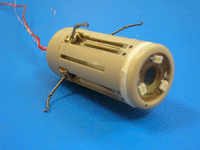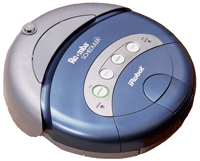
PCT Portraits: The Robot Creators
Since the Patent Cooperation Treaty (PCT) began operating in 1978, more than 1.2 million international patent applications have been filed, covering inventions and new technology of every description. This is the third in our series in which WIPO Magazine picks out a few innovations from among the profusion of PCT applications, and looks at the people behind the patents. This time it is the turn of the new robot creators.
Strap-on Strength
Featured among TIME Magazine’s "Most Amazing Inventions of 2005" we found Professor Yoshiyuki Sankai’s robot suit.
The story of Professor Sankai’s invention began with typical boyhood dreams of bionic limbs capable of endowing their owner with superhuman strength. But unlike most small boys, his fascination with robotics was to grow with him. "As a child, I was thrilled at the possibility that technologies can help people expand their (physical) abilities. And I still have that feeling," he told The Japan Times.
At the Institute of Systems and Engineering Mechanics in Japan’s University of Tsukuba, Professor Sankai has developed a strap-on robotic "suit" or exoskeleton. This he conceived not for feats of fantasy, but to enable elderly or disabled people to perform everyday tasks with which they would otherwise struggle, such as walking, climbing stairs or lifting heavy objects.
The suit, known as the Hybrid Assistive Limb, works through fine sensors on the skin, which pick up electrical impulses transmitted from the user’s brain to his or her muscles. An integral computer instantaneously analyses and transmits these signals to sophisticated mechanisms, which gently power-assist the user to achieve the desired actions smoothly. Frames support the wearer’s legs and provide stability. "The most difficult part was to develop a system to gauge the user’s intention," explained Professor Sankai. "If the motors started moving one-trillionth of a second behind, it would become a drag to the user."
Professor Sankai believes that scientists have an important role in spurring the creation of new industries and encourages his young researchers to be proactive in launching business ventures. In 2004 he founded Cyberdyne Inc. at Tsukuba University in order to commercialize the robot suit rapidly. The price of the customized suit notwithstanding, orders are coming in steadily. And with problems of caring for the elderly becoming more acute in Japan’s rapidly aging society, the demand for robotic home help is set to rise. (For more information see www.cyberdyne.jp)
Inside View
What can be swallowed in a pill, then crawls through the large intestine taking video shots?
 The "endoscopic legged capsule" – inspired by the crawling movement of insects. (Courtesy of A. Menciassi/IMC)
The "endoscopic legged capsule" – inspired by the crawling movement of insects. (Courtesy of A. Menciassi/IMC)
The thought alone might turn the stomach. But anyone facing the prospect of an intestinal examination or surgery will welcome news of this micro robotic capsule, under development by a team at the Sant’Anna School of Advanced Studies in Pisa, Italy. The joint Italian-South Korean project is led by 34 year old biomechanical-engineeer, Arianna Menciassi, and supported by the Intelligent Microsystem Center in Seoul.
The concept of a camera-in-a-pill for use in colonoscopies is not new in itself. But devices currently available to doctors cannot be controlled externally, and are simply squeezed along the gut together with whatever else the patient has ingested. "It’s like watching the view from a train window," explains Arianna Menciassi. "If you see something of interest, there’s no way to turn back and get a better look." To solve the problem, the team drew inspiration from the crawling motion of insects, and came up with a radio-controlled micro robot with hooked legs and tiny teeth to grip the intestinal wall. To direct it, the operator requires no more technical skill than for a video game. Minimally invasive, the capsule is expected to reduce the discomfort normally associated with a colonoscopy. Human trials will begin in two to three years.
Dr. Meciassi and the team were closely involved in the patent application process. "The PCT," she told us, "is the traditional process we follow in my Institute for knowledge protection. In this case we started with an Italian application and within one year we presented a PCT application." (For more information see www.microsystem.re.kr )
From Dust Buster to Bomb Disposal
As a student of computer science and mechanical engineering at the Massachusetts Institute of Technology (MIT), U.S., Helen Greiner used to enthuse to her parents about the role of robots in space exploration. Her work at NASA’s Jet Propulsion Laboratory fuelled her passion. But her mother, pushing a vacuum cleaner round the house, was underwhelmed. "That’s great, honey," she sighed, "but what I really want is a robot that can clean these hard-to-reach places."
 The Roomba navigates its way around a room, detecting and sucking up dirt. Dozens of sensors constantly adjust its behavior. (Courtesy of iRobot Corp.)
The Roomba navigates its way around a room, detecting and sucking up dirt. Dozens of sensors constantly adjust its behavior. (Courtesy of iRobot Corp.)
Helen Greiner is now chairman of iRobot Corporation, the $95 million company which she co-founded at aged 23 with two fellow MIT roboticists. Helen’s mother has her vacuum cleaning robot, the Roomba. As do over 1.5 million other iRobot customers.
Building on the firm’s proprietary technology, iRobot rapidly expanded beyond consumer products to robotics for government and industrial applications. The MicroRig, for example, is designed to carry out tasks deep inside oil wells. The PackBot, currently on active service with the U.S. military, is a remote-controlled reconnaissance and bomb disposal robot, which first made headlines when the prototype was summoned from the laboratory to search through rubble in the September 11 rescue efforts at the World Trade Center. In 2002 another iRobot robot conducted a televised search of the Great Pyramids of Egypt, in cooperation with the National Geographic Society.
"The great thing about robotics," says Helen Greiner, "is that the field is still in its infancy. It’s totally creative." In an interview with PBS’ Ask the Scientist, she evokes her favorite ideas, such as agri-bots, that would "live" in farmers’ fields, constantly searching for and removing weeds and pests, thus eliminating the need for toxic pesticides and herbicides. As science fiction becomes science fact, "I am living my own dream," she says.
iRobot Corporation has 15 published PCT applications covering new robotics technology. (For more information see www.irobot.com)
By Elizabeth March, WIPO Magazine Editor
The WIPO Magazine is intended to help broaden public understanding of intellectual property and of WIPO’s work, and is not an official document of WIPO. The designations employed and the presentation of material throughout this publication do not imply the expression of any opinion whatsoever on the part of WIPO concerning the legal status of any country, territory or area or of its authorities, or concerning the delimitation of its frontiers or boundaries. This publication is not intended to reflect the views of the Member States or the WIPO Secretariat. The mention of specific companies or products of manufacturers does not imply that they are endorsed or recommended by WIPO in preference to others of a similar nature that are not mentioned.